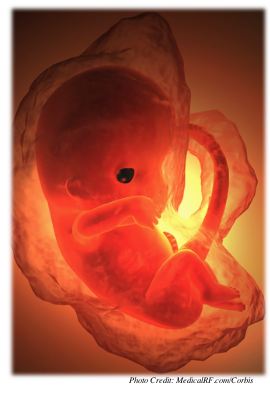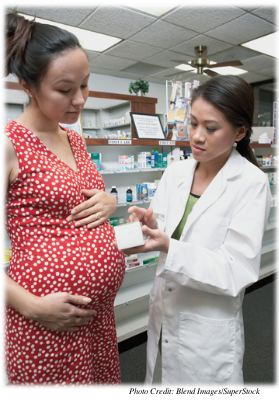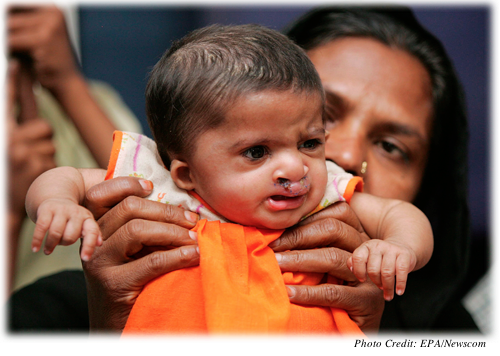

Chapter 1. Teratogens
Synopsis

Teratogens

Author
Catherine F. Robertson, Grossmont College
S. Stavros Valenti, Hofstra University
Synopsis
Teratogens are substances and conditions that can impair prenatal development and lead to birth defects or even death. Teratogens may include medications, diseases, infections, environmental pollutants, psychoactive drugs, and even poor nutrition.
REFERENCES
Berry, R. J., & Zhu, L. (2002). Folic acid alone prevents neural tube defects: Evidence from the China study. Epidemiology, 13, 114–116.
Cohen, L., Friedman, J., Jefferson, J., Johnson, E., & Weiner, M. (1994). A reevaluation of risk of in utero exposure to lithium. JAMA 27(12), 146–150.
Friedman, J., & Polifka, J. (1994). Teratogenic effects of drugs: A resource for clinicians (TERIS). Baltimore, MD: The Johns Hopkins University Press.
Lightfoot, C., Cole, M. & Cole, S. R. (2009). The Development of Children (6th ed.). New York: Worth Publishers.
Moore, K., L., & Persaud, T. V. N. (1998). The developing human: Clinically oriented embryology. Philadelphia: Saunders.
Mountain States Genetics. (1995). Teratogen update. Genetic Drift, 12. Retrieved August 29, 2005, from http://www.mostgene.org/gd/gdvol12h.htm
Nelson, C., & Demmler, G. (1997). Cytomegalovirus infection in the pregnant mother, fetus, and newborn infant. Clinics in Perinatology, 24, 151–160.
Organization of Teratology Information Services (OTIS). (2005). Fact sheets. Retrieved August 29, 2005 from http://otispregnancy.org/otis_fact_sheets.asp
Physical and Theoretical Chemistry Lab. (2005). List of known and suspected teratogens. Retrieved August 30, 2005, from http://ptcl.chem.ox.ac.uk/MSDS/teratogens.html
The Teratology Society. Metabolic teratogens. Retrieved August 29, 2005, from http://teratology.org/jfs/teratologyindex.html
The Teratology Society. Pharmaceutical teratogens. Retrieved August 29, 2005, from http://teratology.org/jfs/teratologyindex.html
The Teratology Society. Recreational teratogens. Retrieved August 29, 2005, from http://teratology.org/jfs/teratologyindex.html
Trasler, J., & Doerksen, T. (1999). Teratogen update: Paternal exposures-Reproductive risks. Teratology, 60, 161–172.
Teratogens: The Germinal Period

The term teratogen refers to any environmental insult to the developing fetus at any point during the prenatal period. A teratogen can cause structural abnormalities, central nervous system damage, mental retardation, and slowed intrauterine growth. It may even terminate a pregnancy.
It is believed that if exposure to teratogens occurs during the germinal period, which is the first two weeks of gestation, the teratogenic agent will probably destroy the organism before implantation occurs. During the germinal period, it is estimated that approximately 45 percent of pregnancies end in spontaneous abortion, which may occur before a woman even realizes that she is pregnant.
Teratogens: The Embryonic Period

Beginning at the third week of gestation and continuing throughout the embryonic period, susceptibility to most teratogens is at its greatest. The reason for this is because all of the major organ systems, such as the circulation, nervous, and digestive systems, are beginning to develop during this time. The movement of cells to their final destinations and the differentiation of cells into their specific roles can be disrupted if the chemistry of the uterus is changed by the introduction of a teratogen, such as alcohol, the HIV virus, or radiation.
Radiation, for example, appears to have a teratogenic effect on fetal brain development, specifically between the eighth and sixteenth week of gestation. During this period of prenatal development, large numbers of brain cells are forming and moving (“migrating”) to their final positions. Radiation can disrupt this migration and interfere with the development of the brain.
Principles of the Influence of Teratogens

Many factors affect how a teratogen does or does not interfere with the fetus’s growth. The introduction of a teratogen or teratogens certainly increases the risk of developmental problems for the fetus, but the presence of a teratogen or teratogens does not guarantee that there will be any problems. While the effects of teratogens on the fetus vary tremendously, there are some principles that hold true about the influence of teratogens on fetal development.
– Genetic vulnerability: Certain women and certain fetuses may be more or less vulnerable to particular teratogenic agents because of their genetic inheritance, or genotype.
– Timing of exposure: The age of the developing fetus is critical in determining a teratogen’s effect. Some teratogens only affect development during a highly precise and/or narrow range of time (e.g., thalidomide) while other teratogens can harm the fetus at any point or across a broader range of time (e.g., alcohol).
– Amount of exposure: The greater the dose of or duration of exposure to a teratogen or to multiple teratogens, the likelihood of a fetal response or reaction increases.
– Specific effects: Each teratogen acts in a distinct manner on specific cells of a developing organism to cause a potentially debilitating pattern of abnormal development. For example, the drug thalidomide generally only causes deformity in the arms and legs.
– Maternal condition: The mother’s age, nutrition, and physical and emotional condition all affect how a teratogen might impact a fetus.
– Whether the mother is affected: Some teratogens that have minimal to no risk to the mother may pose a great threat to the developing fetus. In some cases of rubella (German measles), the pregnant mother may only mildly affected and may not even be aware that she is infected while her fetus is at serious risk.
Interaction of Teratogens

In many pregnancies, more than one teratogen may introduced, such as a mother with poor nutrition habits who suffers from liver dysfunction. The presence of multiple teratogens can lead to an interaction effect or even a cumulative effect.
In the case of a woman who smoked and used alcohol throughout her pregnancy, the combined effect of both smoking and drinking does much more harm to the fetus than either one of these teratogens could do alone.
Categories of Teratogens
Under each category below, a few representative teratogens are shown. On the next screen, you will be asked to categorize some of these substances and conditions.
| Medicines | Maternal Diseases and Infections | Environmental Pollutants | Psychoactive Drugs | Poor Maternal Nutrition |
|---|---|---|---|---|
| any drug prescribed by a doctor as well as over-the-counter drugs and remedies | viruses and diseases that can harm or interrupt development in the womb | pollutants in the air, soil, water, or food that may have teratogenic effects | non-prescription and non-medicinal drugs that affect the mind | diet that includes foods that pregnant women should avoid or lacks certain vitamins or minerals, proper caloric intake, or sufficient protein or fats |
| Examples | Examples | Examples | Examples | Examples |
| Accutane (used for acne), Tetracycline & Streptomycin (antibiotics), Excedrin Extra Strength | rubella (German measles), syphilis, HIV/AIDS | lead, mercury, radiation | alcohol, cocaine, heroin, marijuana, tobacco | lack of folic acid, excess caffeine, raw or undercooked meat, fish, and eggs |
Review of Categories of Teratogens

For each teratogen, indicate the category to which it belongs.
1.
Alcohol
Streptomycin
Heroin
HIV/AIDS
Lack of folic acid
Tobacco
Lead
Raw or undercooked meat, fish, and eggs
Marijuana
Mercury
Rubella
Radiation
Cocaine
Syphillis
Tetracycline
Excess caffeine
Assessment: Check Your Understanding

2.
1. Risk for the majority of teratogenic effects is greatest during:
Assessment: Check Your Understanding

3.
2. In the space below, please list the categories of teratogens.
Assessment: Check Your Understanding

4.
3. In your own words, explain why exposure to teratogens during the embryonic period carries the greatest risk for developmental abnormalities.
Congratulations! You have completed this activity.Total Score: x out of x points (x%) You have received a provisional score for your essay answers, which have been submitted to your instructor.